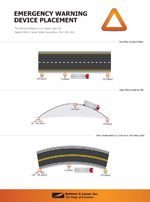Place Emergency Warning Devices to Prevent Roadside Collisions
Parking a commercial motor vehicle (CMV) on the side of the roadway presents very serious hazards to both the driver and other motorists on the road. Because motorists do not typically anticipate a vehicle being parked on the side of the road, collisions frequently occur. Drivers, particularly those who are fatigued, may not realize that a vehicle is stopped and try to move into what they perceive as a lane. If the parked vehicle extends into the driving lane, other motorists may either misjudge the width of their lane or not have an opportunity to move into another lane and strike it. These collisions often occur at high speeds and result in serious damage, injury and even fatalities.
Train your drivers to stop on the roadside only in emergency situations. If there is an emergency, make sure they know what to do to alert other motorists to their presence.
According to Part 392.22(a), the Federal Motor Carrier Safety Regulations (FMCSR) require CMV drivers to immediately activate their vehicle’s hazard warning signal flashers any time an emergency requires them to stop on the traveled portion of a highway or adjacent shoulder. The flashers must be left on until the emergency warning devices are placed according to regulations specified in Part 392.22(b).
Emergency warning devices must be placed within 10 minutes of stopping. When exiting the vehicle to place the devices, drivers should carry them facing oncoming traffic for approaching motorists to see. Reflective triangles, lighted lamps and lighted fuses are examples of acceptable warning devices.
CMV drivers are required to place three warning devices in the following manner:
- On the traffic side of the vehicle, 10 feet or four paces away, in the direction of approaching traffic.
- In the center of the traffic lane or shoulder occupied by the CMV, 100 feet or 40 paces behind, in the direction of approaching traffic.
- In the center of the traffic lane or shoulder occupied by the CMV, 100 feet or 40 paces in front, in the direction of oncoming traffic.
If a hill, curve or any other obstruction prevents drivers from seeing the vehicle, a warning device should be placed at a distance of 100 to 500 feet to give plenty of notice to approaching motorists. If the CMV is stopped on a one-way or divided highway, the warning devices should be placed at 10 feet, 100 feet and 200 feet, facing approaching traffic.
To help your drivers remember how to properly place emergency warning devices, Baldwin & Lyons is offering our Emergency Warning Device Placement handout card pictured below in PDF format. Please refer to the Resource Library for a video training program that can assist you with warning device placement.

{ back } |
